Mekong bobtail in Latvia




(on the materials of the Internet resources and the magazine Koshki.INFO Nr. 02- 2018)
The history of the development of the Mekong bobtail is closely related to the origins of Siamese and Thai cats from the oldest Old Siamese breed, already known in the 10th century. The National Library of Bangkok holds a 14th-century manuscript "Cat Book Poems", which contains descriptions of unusual cats with dark muzzles. Until the end of the XIX century, no one outside the state of Siam did not see Siamese cats. They belonged exclusively to the royal family and enjoyed universal respect and worship. The abduction of a cat from the royal palace, and even more so from the country, was punishable by the death penalty. Over the years, a lot of legends have sprung up around the Siamese cats, and today it is difficult to separate the truth from fiction.

One of the legends that all bobtail breeders like, says that a long time ago in the palaces and temples of Ancient Siam (since 1939. Thailand), located on the banks of the Mekong - the largest river in tropical Asia,there were lived cats of unusual color with dark muzzles , legs and tails, which won the special love of local residents, nicknamed them "lunar brilliants." They guarded the treasure and accompanied the Thai princesses in their walks. During the bathing beauties took off their jewelry and threaded them on the broken tails of cats, from which the jewels could not fall to the ground and get lost.
It is believed that for several hundred centuries the Old Siamese cats were akin to domestic deities - they were only planted by the nobility, and commoners could only admire these heavenly-eyed creatures.
Thais people for a long time, guarding the breed, were forbidden to take these beautiful animals out of the country. The cats of the national breed could only be donated to highly respected foreigners. Thus, at the end of the 19th century, they began to enter Europe, Russia and America.
So, in 1867, the governess of the children of King Siam returned to England with a pair of kittens, and in 1870 two temple cats were received as a gift from the British consul in Bangkok, Suen Hood. The consul was given the kittens by the King of Siam himself, considering it the highest reward. It was these little ones who became the forefathers of the Siamese breed. Cats caused a furore in Europe and the generous king in 1871 sent several dozen royal cats as a gift to high-ranking European personalities. After 1920, the first cats arrived in America, traveling from modern Thailand across the ocean to the New World. Many of these animals had creases and hooks on their tails, which was a sign of the royal cats, but the selection work went on the way of culling animals "with a flaw." An intensive breeding of this exotic breed for the felinologists of that time began.
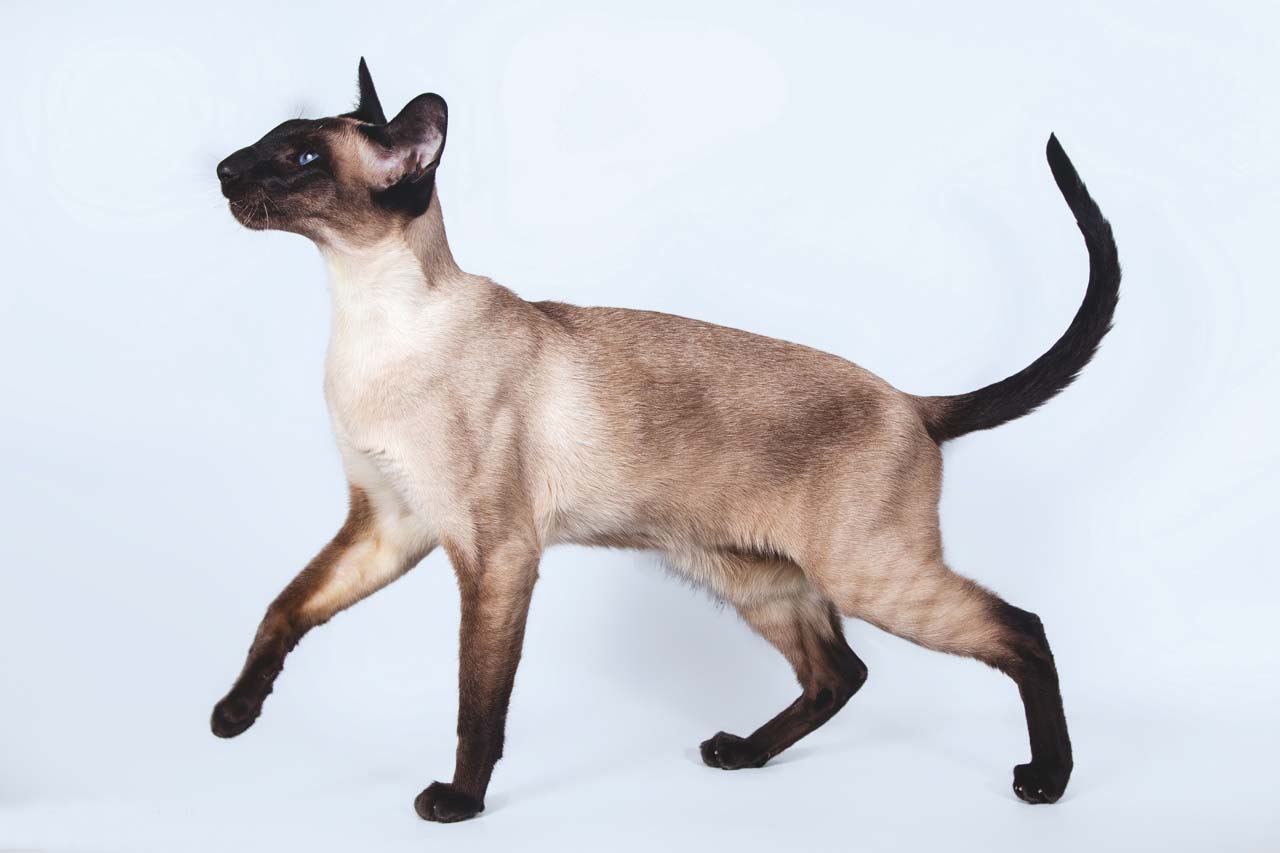
Siamese cats began to "straighten their tails" and change some other signs, thus creating a new Siamese breed. As a result of the selection work, the species of Siamese began to change and acquired an extremely refined type with a wedge-shaped head, large ears, tall slender elegant legs and a long, whip-like tail. The Standard of the Modern Siamese Cat, approved by TICA (USA) in 1991, and GCCF (Great Britain) in 1993.
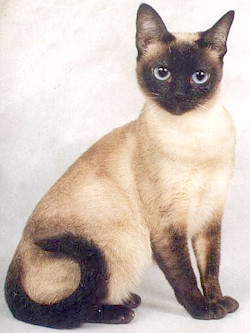
However, there were also fans of such Siamese cats that were closer in appearance to the old Siamese (muscular animals with a rounded body, well-built, with medium-length limbs and a short tail, slightly pointed at the end). The standard of such breed was approved by the WCF in 1990 as a Thai cat - in honor of the state of Thailand, which used to be called Siam.
And only in the 21st century it was discovered that the Old Siamese cats had one more branch of development that began in 1897, when the Siamese King Chulalongkorn (Rama V) presented 200 palace cats to Nicholas II (Nicholas II, in gratitude for this gift, provided the Rama V Guards Unit for protection of the Grand Royal Palace). So the short-tailed cats came to Russia to the houses of the Russian nobility. Perhaps, after many tragic events in Russia, this amazing breed would be lost with its own distinctive features, if it were not for the enthusiasts who in the second half of the century started to support and update the population, renewing its original genotype and adding to the local Bobtails the true Old Siamese blood of cats, brought from countries of southeast Asia, where short-tailed grace is common.
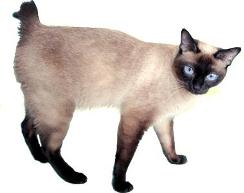
Its present name Mekong bobtail breed was recently received - along with its official recognition of the WCF system in 2004, than it was finally confirmed its uniqueness and difference from other Thai and Siamese cats. Mekong bobtails (the old name Thai bobtails) is one of the living legends of the cat's world. To date, this breed is considered rare - there are no more than 400 such cats (documented) in the world. The modern name emphasizes their origin. Mekong is a long river of the Indochina peninsula that flows through the territories of China, Laos, Thailand, Cambodia, Myanmar (Burma) and Vietnam.
The Mekong bobtail is recognized in several felinological systems. When the standard was adopted, it was indicated in contrast to the Thai head structure, putting eyes, size and ear set, limb heights, body format, tail size and design. This is the reason that the adopted standard of the Mekong bobtail does not permit mating with Thai cats.
Mekong bobtail:
| Part of the body | Description |
|---|---|
| General form | Original short-haired blue-eyed cats with a color-point color with short tails. |
| Body | Rectangular, medium in size, muscular, but rather slender, with strong bones. The back is almost straight with a minimal increase to the rump. Neck of medium length or short. Male cats are larger than female cats. |
| Head | Round or in the form of a short blunt wedge, the upper part of the skull is almost flat, cheekbones are rounded, with a strong chin, cats are noticeable in the cats. Nose of medium length, Roman or straight, transition at eye level or lower. The muzzle is clearly oval with a transition in the region of the vibrissae. |
| Eyes | Large, oval or rounded. Clear and clear bright blue/blue eyes. |
| Ears | Large or medium-sized, broad at the base, with slightly rounded tips, high set and slightly diluted. The outer edge of the ear is slightly retracted. |
| Limbs | Medium in height, slender, muscular. Paws small, oval, graceful. The mekong bobtails do not remove the claws on their hind legs, and they clink on walking like dogs. Mekong bobtails almost do not scratch and, defending themselves, rather bite than scratch. |
| Tail | The Mekong bobtails have unique tails. Each short tail has its own, only its characteristic bends, kinks and loops (incorrectness) with mandatory incorrectness at the base. Not all of them can be seen under the coat. But it is possible to feel, having felt a tail. So the tail of a mekong-bobtail is his "passport". It consists of hooks and knots in any combination. It is mobile as a single structure. In short, three centimeters is unacceptable. Disqualification - the tail is longer than a quarter of the body, for the absence of loops and/or curves on the tail. |
| Leather | Loosely adjacent to the muscles almost throughout the body. |
| Wool | Short and thin, with a minimal undercoat friable texture, adjacent to the body. |
| Coloring | Color-point color is set to 10 months or later. White patches or individual white hairs on points are inadmissible. |
In all its appearance and habits, the Mekong Bobtail shows the belonging to the higher society of blue blood cats - they are proud, majestic and independent, but at the same time they are living cats with a high degree of mobility. They are non-aggressive, kindest creatures with a sympathetic and extremely sociable character. At the same time, they are unobtrusive, adore their masters, they are necessarily next to them, showing their love - sometimes they start licking their hands, cheeks and even slightly biting them. Curious, attentive, understandable, playful. They do not like being alone. They like to sit with people very much, they always meet and plaintively miachat when everyone leaves. By nature, they really resemble something small dogs, like different sticks and objects similar to chopsticks, mostly just with them and play, and the usual cat toys are not very interested.
Mekong is a universal cat that adapts itself to the owner and becomes a faithful and devoted friend. She fully understands all that the owner wants, does not fail, he obeys and behaves as the host should. Such cats can be safely taken with them on a trip or for a walk, without worrying about that they will be lost. Pets prefer to stay close to the owner. Moving to a new place of residence, too, will not cause panic, they are more used to people than to their habitat. These are true companions.
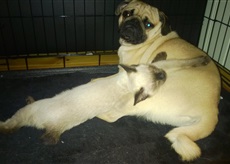
Mekongs usually get along well with other animals in the house and never create conflict situations. Excellent friends with relatives, other cats and dogs.

In addition, these cats are good for young children and with angelic patience suffer many manifestations of childlike love. Mekong bobtails will never offend a child - pets are willing to tolerate any childish abuse without resentment, however long the latter lasts (the mekong is very patient with the child, even when in a doll's crib and with a cap on his head). Perhaps the angelic patience is associated with the unusual structure of the animal's skin: it loosely adheres to the muscles and grasping at the scruff does not cause the cat any special discomfort or unbearable pain.
Mekongi, unlike other cats, never take their eyes off, they can look into their eyes for a long time with their clear-blue eyes. They have a wide range of published sounds, very interesting facial expressions. It seems that the cats are talking to you.
Animals are very clean, easily accustomed to the tray and scratching. Wool enough to comb during moulting, which passes almost imperceptibly. Need clipping claws on the hind legs (when growing to 3 cm).
(what colour are they and how does this affect their character?)
Mekong bobtails are born completely white - completely charming soft lumps of boiling white or slightly creamy hue. A few hours later the spout and ears of the kitten begin to stain, literally in front of ... In my youth, all mekong-bobtails have a light, white or creamy body, a bright mask and elegant gloves in tone. During puberty, the body of many mekong-bobtails acquires an adult shade - from blue to the color of milk chocolate (the intensity can vary depending on the temperature).
According to the observations of breeders of the nursery Cofein-Pride, mekongs, the colour of cats directly affects their character (http://www.mekong-bobtail.ru/news/okrasy_mekong_bobtejlov/2011-11-20-12)

Traditional and the most common, all the favorite colour of a kitten named Gav- seal-point. A spectacular black mask and black gloves, a body of melted milk ... The eyes of all shades of sapphire and turquoise look unusually impressive in this colour, favorably accentuated and shaded with a velvet mask. Top of elegance, timeless classics - an unusually aristocratic colour, conquered the hearts of many and many cat lovers! The character of the Mekong bobtails of classical colour is distinguished by an innate aristocracy - elegance and impeccable manners! But in the soul of every mekong-bobtail there lives a cheerful, inquisitive child who disinterestedly loves his family, mobile and mischievous. Mekong bobtail - an unsurpassed intellectual and entertainer - with him is always interesting! |

The brightest and sunniest, the funniest and most optimistic colour - red-point! Red mekong like woven from the sun's rays - it's so bright and glowing! And heavenly blue eyes add purity and lightness to this bright, sparkling image! As a rule, in Mekong bobtails, red-point colour is dazzlingly white, sometimes with a light peach tint. Mask and gloves (points) of any sunny shade - from a delicate peach to a fiery-red. The same light and bright and the temperament of the solar mekongs is an eternal child, cheerful, cheerful and playful. In addition, the Mekong bobtails of the red-point colour differ from fellow-mekongs of other colours, usually more impressive in size and sturdy physique. Rare enough colour for cats breed Mekong bobtail, and become a cat owner of this colour - a great luck. |
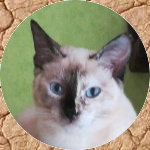
The most mysterious and fascinating colour of the Mekong bobtails is the tortie-point. Its highlight is that only cats represent cake-point, this is the genetic feature of this colour. It looks like a cheerful sunny bunnies freckles, generously scattered on the coat of the point kitty. Among specialists it is customary to call such cats turtles. Turtles have truly magical powers to charm and inspire a feeling of love and worship! But for the love of tortoises pay unlimited reciprocal love, devotion and even m. It is noticed that the tortoiseshell cat brings happiness to the house and possesses the wonderful abilities of the healer, they are excellent psychologists and delicately feel the mood of the master - they try to please him in every possible way. Turtles are a real genetic gift for the breeder! |

Very rare, but conquering the increasingly popular colour is the delightful blue-point. The coat of Mekong bobtails of this colour argues with brilliance and luxury with blue mink fur! Very beautiful look silvery-bluish-pearly points on a light body of icy-silver or slightly creamy hue. Extraordinarily bright, as if glowing from the inside, the eyes of blue-point mekong bobtails have a special bright blue hue. Blue Mekong bobtails are characterized by unusual softness and tenderness, friendliness and impeccable manners, love for children and cubs of all kinds and ages. These are the greatest altruists of all mekong bobtails. But to these blue princes and princesses, universal love is necessary as air! They are born to love and be loved. Without attention and care they are very afflicted. |

Even more rare, precious, legendary colour - chocolate-point! Effectively stands out with festive elegance. "Chocolates" are born absolutely snow-white, like the first snow and this magic property remains with them forever! Taurus "chocolate" remains snow-white or soft cream throughout their life, while the points have an appetizing, warm tone of chocolate or noble cognac. Eyes often have an unusual lilac shade. "Chocolates" are very high in intelligence, innate aristocracy, cleanliness, expressed qualities of the leader and attachment to their human family. But the features of the character of the mekong bobtails of the chocolate-point colour are yet to be studied. |
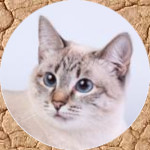
Tabby-point - very beautiful, unusual, rare colour. A luxurious outfit Mekong bobtails of this color have won many hearts: a pattern of tabby (strips of some color) delicately emerges on a snow-white or slightly tinted coat with a patterned lace. Points have a more gentle tone than the usual point colors. Tabby variations can be of all point colors, a feature is a characteristic drawing on the muzzle in the form of a letter M. According to legend, the letter "M" is a testament of the Divine reward. As is known from the Gospel, the Virgin Mary gave birth to Jesus in the stable. According to legend, the Newborn screamed and trembled from the cold, and the mother did not know how to reassure the Baby. And suddenly out of the dark came a cat. She lay down next to the Child, warmed Him and began to purr. The child died down and fell asleep. In gratitude, Maria inscribed the first letter of her name on the cat's forehead. Mekong bobtails of tabby-point colour differ more in cat's essence, rather than their point brothers. They are more independent and self-sufficient, but also more elegant and graceful. Most of the Mekong bobtails - tebbiks are incredibly beautiful, very large eyes of deep cornflower blue or bright blue. |
Even more rare colours are obtained by breeding. - lilac - point, cream - point and other. |